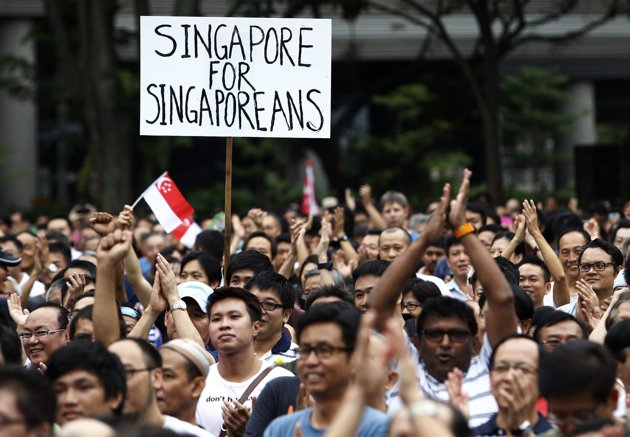Brenda Walker
VDare
June 7, 2014
Somehow the people of Singapore missed the message from elites that massive diverse immigration is the best idea ever. Average folks have showed up in the thousands to protest the importation of foreign workers, including a group on this year’s May Day, even though public demonstrations are rare events there.
Below, thousands of Singaporeans protested immigration on May Day 2013.

Singapore is already one of the most densely populated nations on earth, with nearly 20,000 humans per square mile. Furthermore, companies prefer to hire cheap exploitable foreigners to replace qualified local people.
Where have we heard that before?
Anyway, the finance minister has announced that the government will lower the number of foreign workers to maintain social stability. (Funny how the “I” word — immigrants — doesn’t show up in this article.)
Let’s hope it happens, so we can observe a sensible immigration strategy that emphasizes the well being of citizens workers and the preservation of the national culture over saving a few nickels.
Singapore finance minister accepts slower growth as trade-off for social stability, Reuters, June 6, 2014
(Reuters) – Singapore is willing to accept slower growth as a trade-off for social stability as it aims to keep down the number of foreigners working in the city-state, Finance Minister Tharman Shanmugaratnam told Reuters.
Over the past decade, Singapore’s economy has expanded by a 6.4 percent annual average. Tharman said that he would be happy if Singapore grew 3 percent a year, as long as growth was driven mainly by gains in productivity.
“Three percent growth is good growth,” he said during an interview on Thursday.
High past growth has brought rising numbers of foreigners to work in wealthy Singapore, which in turn has spurred discontent among citizens angered by the strains put on infrastructure and services.
Between 2000 and 2013, Singapore’s population rose to 5.4 million from 4 million, with foreigners accounting for the bulk of the 35 percent increase.
Unhappiness about inflows of foreigners helped an opposition party gain ground in the 2011 general elections as the People’s Action Party, which has ruled Singapore since independence in 1965, won only 60 percent of votes, its worst showing to date. The next election must be held by January 2017.
Tharman, who is also a deputy prime minister, said the government accepts a slower growth rate as the cost of ensuring the country retains its national identity, combats over-crowding and keeps the ratio of foreign to local workers at around one-third.
NOT LIKE DUBAI “We are never going to be Dubai, we are a country with a social ethos that we take very seriously,” the 57-year-old finance minister said.
The number of foreigners in Dubai is larger than that of locals, a result of its aggressive economic growth strategy.
At the end of 2013, there were 1.32 million foreigners in Singapore who held employment or work-passes, around 38 percent of the total work-force.
In 2010, Singapore launched a 10-year plan to restructure its economy, aiming to increase productivity and cap the ratio of foreigners in the workforce at around one-third. The plan aimed to raise the productivity rate by an average of 2 to 3 percent a year, though it actually fell in 2012 and 2013.
In line with the plan, the government has imposed regulations to curb hiring of overseas workers in some sectors.
Now many companies, particularly in the construction and hospitality sectors, are clamoring for a let-up in the rules, saying they are hurting their businesses.
Last week, Prime Minister Lee Hsien Loong said the government would delay S$2 billion ($1.59 billion) of construction projects in order to reduce demand for foreign labor. [ID:nL3N0OE2KM]
Tharman said no tweaks would be made to the rules to help companies in the sectors that are struggling, as they had to adjust and find more productive ways of working instead.
“Giving them a little more slack can make some sense in the short-term but it delays that long-term transition,” he said.
“We know that this is a transition that can be done, it’s not inventing something that hasn’t been done elsewhere.”
SOME INDUSTRIES WILL EXIT For some companies though, he said, the rules may ultimately mean they have to leave Singapore as its economy becomes less competitive for some industries.
“You can’t move into higher value, high innovation activities without freeing up labor and land from the old activities, but you have to leave it to the market,” Tharman said.
There are concerns that unhappiness about the number of foreigners in Singapore is causing some citizens to become hostile towards them.
Last month, organizers of a planned celebration on Singapore’s main shopping street of Philippine independence day canceled it after online abuse directed at the Filipino community.
Tharman said he didn’t believe xenophobia was a major problem among Singaporeans or a threat to foreign investment.
Citizens “would be concerned for valid reasons if there is overcrowding in the buses or in their housing estates” he said. “But I don’t think they are motivated in an unhealthy way.”
In 2013, Singapore’s economy expanded 3.9 percent. The government forecasts growth of 2-4 percent this year. Curbs on hiring foreign workers and steady economic growth mean the labor market is particularly tight, with unemployment hovering around 2 percent.
 Daily Stormer The Most Censored Publication in History
Daily Stormer The Most Censored Publication in History


